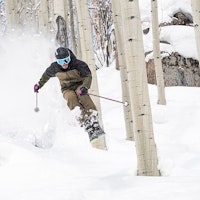1998 I 1999 I 2000 I 2001 I 2002 I 2003 I 2004 I 2005 I 2006 I 20072 0 0 2
ORAGE MASTERS ARRIVES IN MAMMOTH
Teams were put together based on athletes’ ski sponsors to compete for non-cash prizes including snowmobiles and big screen TVs. “We had a growing spring festival at the time and Jamie Brandon at Orage came to us with this anti-comp,” says Oren Tanzer, now park manager at Mammoth. “Immediately I said yes. I’m a true believer that athletes, whether they are skiing for the first time or are the best in the world, if they are happy, they will perform at a high level.” “We tried to build courses that were un-traditional, with a loose comp format. We wanted all the best athletes to come to Mammoth and have a great time and at the end, walk away with a bunch of crazy products.”
— Oren Tanzer
ARMADA AND 4FRNT LAUNCH
Salomon’s Guy Berthiaume on Independent Companies:
“Independent ski companies brought something good to marketing and product. It is a part of the evolution in skiing. Yes, it’s another company, another competitor, but they have helped keep the sport fresh. It’s good for everybody. I believe they were very instrumental in the way the sport has evolved.”
Chris O’Connell on Armada:
“It’s funny, the big ski companies at first weren’t stoked on us, I think they may have felt threatened. But now they all see that we helped breathe new life into skiing and they support the movement. It hasn’t all been pretty, at some times it’s been nightmarish, but now we have an international brand name that represents skiing as it should be. I’d like to think we were a catalyst for change within the ski industry and it now seems to be a collective effort by all the manufacturers, large and small, which puts skiing in the right position for the future.”
Matt Sterbenz on 4FRNT:
“It is a project we started to form leadership within the ski community. It began in 2002; during a period when freeskiing was becoming established, yet the products on the market struggled for direction. The mission was to attract the sport’s best riders, provide a platform for them to design signature products and by result, become leaders in the sport, remain committed to our core values and our enduring commitment to our mission statement.”
DAVID CRICHTON SHOWS HOW HIGH SKIERS CAN GO AT THE WSI
By 2002, The World Ski and Snowboard Festival was one of the must-visit events of the season for skiers looking to make a name for themselves, especially in the halfpipe. The event, which was started in 1996 by Doug Perry, was unique in the way it not only attracted the top athletes, but also attracted unprecedented numbers of spectators.
A big part of the superpipe competition was the Super Hit contest, and still is today. In a jam-session format, the competitors take turns making a single hit in the pipe. In 2002, David Crichton threw the biggest and most stylish alley-oop flatspin 540 the world had ever seen. He won the contest hands down, and the ensuing sequence that ran in all the mags, as well as the video of the trick appearing in movies, forever ingrained Crichton’s flatspin in everyone’s minds.
“That was basically the first time anyone had seen a skier throw something over 20 feet high in the pipe,” says Josh Berman. “It showed that skis were more conducive to boosting in the pipe than snowboards. It was unlike anything anyone had ever seen.”
X GAMES MOVES TO ASPEN
After dabbling at Crested Butte and Mount Snow for two years apiece, ESPN’s Winter X Games finally found a 10-year home at Aspen/Snowmass, Colorado. ESPN’s choice to host Winter X at Buttermilk Mountain has helped firmly establish the resort as a prominent supporter of freeskiing, especially park and pipe. “All of the events at Winter X were evolving very quickly at the time we moved to Aspen,” says Chris Schuster, of EPS-Events. “We needed to be somewhere that embraced these changes and pushed them along. Aspen has been a huge asset to the growth of our sport because it embodies the skiing lifestyle. At their roots, all of the sports at Winter X are so much about lifestyle, so it has really been a perfect match.”
![[GIVEAWAY] Win a Legendary Ski Trip with Icelantic's Road to the Rocks](https://www.datocms-assets.com/163516/1765233064-r2r26_freeskier_leaderboard1.jpg?w=200&h=200&fit=crop)
![[GIVEAWAY] Win a Head-to-Toe Ski Setup from IFSA](https://www.datocms-assets.com/163516/1765920344-ifsa.jpg?w=200&h=200&fit=crop)


![[GIVEAWAY] Win a Legendary Ski Trip with Icelantic's Road to the Rocks](https://www.datocms-assets.com/163516/1765233064-r2r26_freeskier_leaderboard1.jpg?auto=format&w=400&h=300&fit=crop&crop=faces,entropy)


![[GIVEAWAY] Win a Head-to-Toe Ski Setup from IFSA](https://www.datocms-assets.com/163516/1765920344-ifsa.jpg?auto=format&w=400&h=300&fit=crop&crop=faces,entropy)



